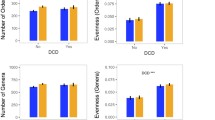Abstract
Common methods of assessing the biological impact of point source discharge involve a census of organisms above and below the discharge. The identification and enumeration of organisms necessary for this approach can be time consuming and costly. When microbial communities are used, identification and enumeration are often impossible because the majority of species are identifiable only when cultured and most native species cannot be cultured. As such, little is known about the response of nonculturable aquatic microbial communities to anthropogenic changes. We isolated aquatic microbial DNA from colonized artificial substrates in two streams receiving industrial waste. DNA was isolated from the microbial communities upstream and downstream of the discharges and the similarity of these communities were compared by DNA-DNA hybridization. These novel estimates of impact were compared to more conventional estimates based on a component of the microbial communities that could be readily identified, the protozoans. Protozoan species were identified and similarity between upstream and downstream stations was assessed using Jaccard's similarity index.
In the Roanoke River, protozoan species richness was significantly lower at the downstream station. Both Jaccard's coefficients and DNA hybridizations indicated that upstream communities were more similar to each other than with the downstream site. However, these differences were not significant. Estimates of community similarity from Jaccard's coefficients and DNA hybridizations were not correlated. In Peak Creek, protozoan species richness was significantly lower at the downstream station. Jaccard's coefficients and DNA hybridizations were not significantly higher within upstream stations than between upstream and downstream stations. The two similarity measures were not correlated. Problems in this preliminary study included small sample sizes and highly variable background on hybridization membranes resulting from the use of nonradioactive DNA probe label and detection methods. Alternative approaches using radioisotopes or COT curves may be more viable means of making molecular methods a useful tool in impact assessment.
Similar content being viewed by others
References
Cairns, J.Jr, 1982. Freshwater protozoan communities. In: A. T. Bull & A. R. K. Watkinson (eds),Microbial Interactions and Communities. pp. 249–285. Academic Press, Inc., London.
Chan, V. T-W., K. A. Fleming & J. O'D. McGee, 1985. Detection of subpicogram quantities of specific DNA sequences on blot hybridization with biotinylated probes. Nucleic Acids Res. 13: 8083–8091.
Fuhrman, J. A., D. E. Comeau, A. Hagstrom & A. M. Chan, 1988. Extraction from natural planktonic microorganisms of DNA suitable for molecular biological studies. Appl. Eviron. Microbiol. 54: 1426–1429.
Henebry, M. S. & J. CairnsJr, 1980. Monitoring of stream pollution using protozoan communities on artificial substrates. Trans. Amer. Micros. Soc. 99: 151–160.
Holben, W. E. & J. M. Tiedje, 1988. Applications of nucleic acid hybridization in microbial ecology. Ecology 69: 561–568.
Holder-Franklin, M. A., A. Thorpe & C. J. Cormier, 1981. Comparison of numerical taxonomy and DNA-DNA hybridization in diurnal studies of river bacteria. Can J. Microbiol. 27: 1165–1184.
Jongman, R. H. G., C. J. F. ter Braak & O. F. R. van Tongeren, 1987.Data Analysis in Community and Landscape Ecology, Pudoc, Wageningen. 299 pp.
Kaesler, R. L., J. CairnsJr & J. S. Crossman, 1974. Redundancy in data from stream surveys. Water Res. 8(9): 637–642.
Lee, S. & J. A. Fuhrman, 1990. DNA hybridization to compare species compositions of natural bacterioplankton assemblages. Appl. Environ. Microbiol. 56: 739–746.
Niederlehner, B. R., K. W. Pontasch, J. R. Pratt & J. CairnsJr, 1990. Field evaluation of predictions of environmental effects from a multispecies-microcosm toxicity test. Arch. Environ. Contam. Toxicol. 19: 62–71.
Peng, Li, P. P. Medon, D. C. Skingle, J. A. Lanser & R. H. Symons, 1987. Enzyme-linked synthetic oligonucleotide probes: nonradioactive detection of enterotoxigenicEschericia coli in feacal specimens. Nucleic Acids Res. 15: 5275–5287.
Pratt, J. R., 1990. Aquatic community response to stress: prediction and detection of adverse effects aquatic toxicology and risk assessment. In: W. G. Landis & W. H. van der Schalie (eds),Aquatic Toxicology and Risk Assessment, Vol. 13. pp. 16–20. Amer. Soc. Test. Materials, Philadelphia, Penn.
Sambrook, J., T. Maniatis & E. F. Fritsch, 1989. Molecular Cloning: A Laboratory Manual, Second Edition. Cold Spring Harbor Laboratory, Cold Spring Harbor, New York. 1425 pp.
Sayler, G. S. & A. C. Layton, 1990. Environmental application of nucleic acid hybridization. Ann. Rev. Microbiol. 44: 625–648.
Sokal, R. R. & F. J. Rohlf, 1981.Biometry, 2nd edition, W. H. Freeman & Company, New York. 859 pp.
Wills, G., 1990. EPA lists 39 Virginia facilities for toxic discharge cleanup. Virginia Water Resources Res. Center Water News 21(5): 3.
Author information
Authors and Affiliations
Rights and permissions
About this article
Cite this article
Palmer, S.E., Niederlehner, B.R. & Cairns, J. Assessment of pollution impact on aquatic microbial communities based on DNA hybridization and protozoan identification: preliminary method development and comparison. J Aquat Ecosyst Stress Recov 3, 35–44 (1994). https://doi.org/10.1007/BF00045155
Issue Date:
DOI: https://doi.org/10.1007/BF00045155




